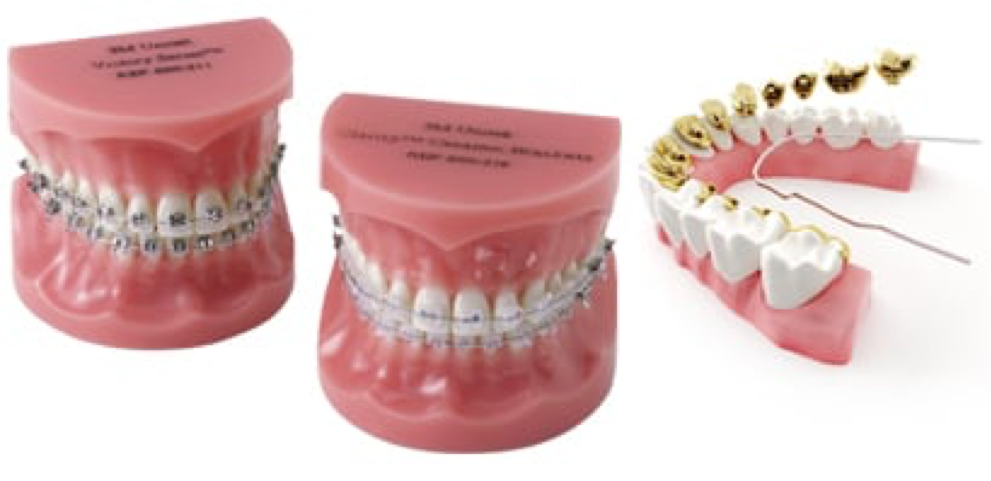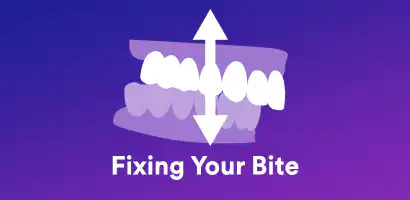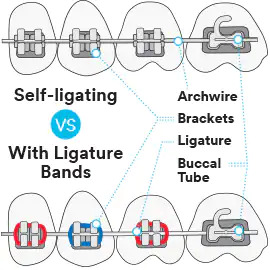Braces & Aligners

The first concern most people have when it comes to getting braces is the look. But braces have come a long way from the large, traditional metal brackets you may have in mind. Today's braces are smaller and sleeker – and some of them are practically invisible. Get ceramic braces for a more natural look, or low-profile metal braces or mini braces for enhanced comfort and esthetics. You can even get braces that sit behind your teeth for a nearly invisible way to straighten your smile.
You may be asking yourself how badly you need braces, and if they're really worth it. While only your orthodontist can evaluate your needs, it is important to know that there are more benefits to straightening your teeth than just having a great smile. Misaligned teeth can hinder your ability to talk or eat comfortably and can cause jaw problems down the line. Getting braces, at any age, can reduce or eliminate these issues while giving you a smile you can be proud of.
What can braces do?
Here are some of the common dental problems that braces can correct. Your orthodontist will recommend the best option for your oral health.

Straighten your teeth.
Teeth don’t always grow the way they’re supposed to. They can come in crooked, overlapping, rotated or even blocking the growth of another tooth. This can make it hard to clean and care for your teeth, and can also place extra strain on your teeth, jaws and muscles.
- Crowded or crooked teeth can make it hard to floss, which can lead to cavities or gum disease – and can get worse with age. Braces bring your teeth into alignment to eliminate overcrowding and straighten your smile.
- Spaces between teeth can also lead to gum issues as you age. Braces can close the gaps for a straighter, healthier smile.

Fix your bite.
If your top and bottom teeth don’t line up when you bite down, it can be difficult to chew. A misaligned bite can make you grind your teeth and can cause painful jaw problems down the road.
- Overbite: The upper teeth cover the lower teeth more than usual when you bite down. Your orthodontist may recommend hidden correctors or other headgear.
- Underbite: The lower teeth extend out more than the upper teeth when you bite down.
- Crossbite: The upper teeth are not aligned to the lower teeth and may “cross over” in the front or sides of your mouth.
- Open bite: There is a gap between the upper and lower teeth when the jaw is closed. Biting and chewing can be difficult.

Improve your smile.
The goal of any orthodontic treatment plan is to improve your oral health. But the position of your teeth can also dramatically affect your appearance. A straight, healthy smile can improve both your self-image and how others perceive you. Fixing your bite can even change your profile by bringing your jaw into alignment.
Today, there are more options than ever to help you feel confident about your smile even while your braces are on. Ask your orthodontist about miniature or clear braces, behind-the-teeth braces, and hidden alternatives to headgear.
What are all the parts?
Orthodontic terminology sounds complicated, but you don't need to be an expert to sound like a pro!
Braces are intricate, but there are really only a few pieces you need to know about. First, you should learn the lingo. When your orthodontist starts talking about your braces, they might refer to them as “appliances,” but that doesn’t mean your braces will be large and clunky. In orthodontia, the word “appliance” just refers to anything that goes in your mouth. Here are the most common terms you’ll need to know:
- Archwire: A wire that connects all the brackets. This wire is tightened to create a gentle pressure to move teeth into place.
- Brackets: The metal or ceramic parts that are attached to the front teeth, incisors and premolars using a dental adhesive. Each bracket helps hold the archwire in place.
- Buccal Tubes: Small metal part bonded to your molars. Each buccal tube has an indent which holds the archwire in place.
- Lingual: The surface of your teeth next to your tongue. Most brackets are bonded to the front of your teeth, but the 3M™ Incognito™ Appliance System sits behind your teeth, on the lingual surface – practically invisible from the front.
- Ligature: A ligature is what holds the archwire in place on the brackets. Most often a ligature is a band (either clear or colorful), but there are also “self-ligating” brackets that hold the archwire with no need for bands. That can mean shorter appointments and easier brushing and flossing.

How do braces straighten my teeth?
No matter which kind of braces you choose, they all work essentially the same way – with gentle, steady pressure. It's a bit like a glacier. You won't see much change from one day to the next, but the results of the movement are visible over time. On average, patients wear braces for a range of time between 6 months to 2 years. As time goes by, you will start to see your perfect smile emerge!
When you know the science behind it, aligning your teeth with braces is actually pretty cool. An archwire is strung through the brackets and bands that are attached to your teeth. Your orthodontist will change the archwire periodically throughout your treatment. The resulting slight tension pushes and pulls your teeth into alignment, actually reshaping the sockets that hold them in place.
During your treatment, you may feel your teeth loosen a little, but don't worry! This is on purpose. The tissue and bone structure will grow to support your teeth in their new positions, so they will stay straight once your braces are taken off. And so you can enjoy your new smile for years to come.